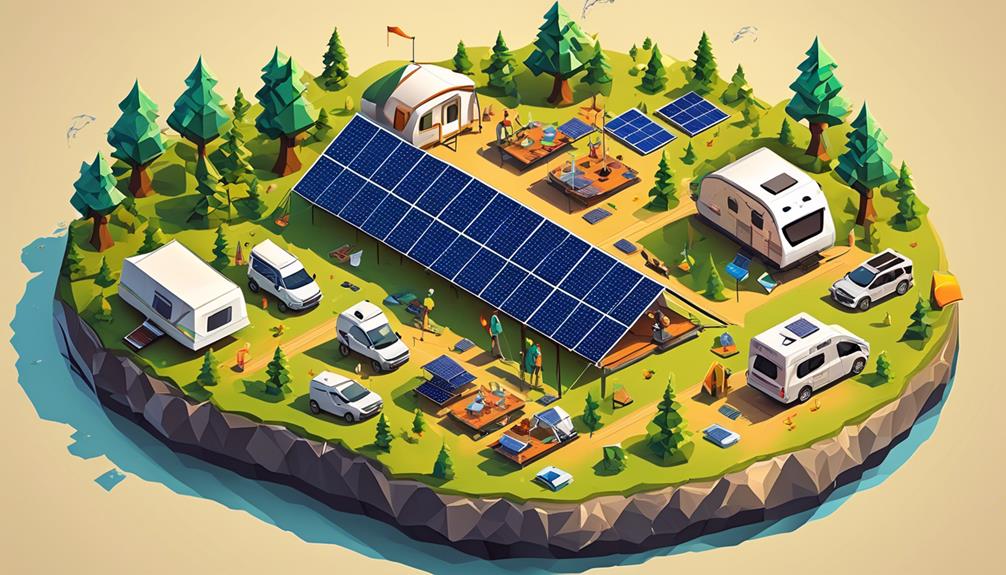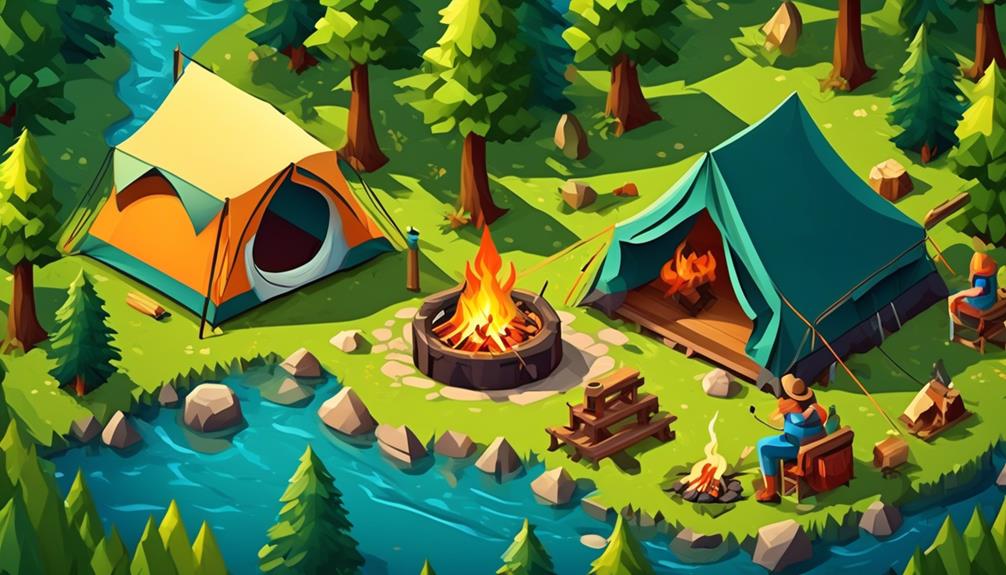Camping statistics are absolutely mind-blowing, revealing fascinating insights into the habits and preferences of millions of outdoor enthusiasts. From the economic impact of camping to the influence of the COVID-19 pandemic on camping trends, these statistics provide a comprehensive view of the camping landscape.
Whether you're a seasoned camper or someone interested in the latest trends, the data on camping is sure to offer some intriguing revelations.
Key Takeaways
- The number of households going camping in 2021 was 56.9 million, with 9.1 million of them being first-time campers.
- Tent camping is the preferred choice for 56% of campers.
- A significant percentage of campers (64%) work while camping.
- Hiking or backpacking activities are popular among campers, with 37% of them engaging in these activities.
Camping Participation Trends
Camping participation trends have shown a significant increase in the number of first-time campers and a shift in camping behaviors due to the impact of the COVID-19 pandemic.
In 2021, 56.9 million households went camping at least once, and notably, 9.1 million of these were first-time campers. The pandemic had diverse effects on camping, with 28% of campers taking more trips, while 46% took fewer trips due to the pandemic.
It's interesting to note that 56% of campers prefer tent camping, and a majority, 64%, work while camping. Additionally, 37% of campers engage in hiking or backpacking activities, indicating a growing interest in outdoor pursuits.
The statistics also reveal a significant shift in the demographics of campers, with Gen Z camping seeing 27% of new campers in 2021, and 34% intending to continue beyond that year. Of these new campers, approximately 50% identify as non-white, showcasing a diversifying interest in camping.
The camping industry itself has experienced substantial growth, with over 15 million Americans camping for the first time in the last two years, and revenue projected to reach $43.89 billion in 2023. These trends highlight the evolving landscape of camping, influenced by both the pandemic and changing demographics.
Impact of COVID-19 on Camping

The impact of COVID-19 on camping has been significant, with restrictions and safety measures altering the landscape of outdoor recreation.
The increased camping demand, particularly among Gen Z campers, reflects a shift in preferences due to the pandemic.
Additionally, the perception of camping as a safer travel option suggests a lasting impact of COVID-19 on recreational choices.
COVID-19 Camping Restrictions
Amid the COVID-19 pandemic, camping experienced both an increase and a decrease in participation. According to a study, 28% of campers took more trips, while 46% took fewer trips due to the impact of COVID-19. These camping restrictions imposed because of COVID-19 have significantly influenced camping trends.
One interesting finding is that COVID-19 has played a role in attracting new campers to the activity. Among Gen Z campers, 43% started camping because of the pandemic. In 2020, 16% of new campers tried camping due to COVID-19, but this number dropped to 8% in 2021.
Moreover, the pandemic has also affected campers' perceptions of safety. In 2021, 55% of campers considered camping a safer option compared to other forms of travel. This shift in perception highlights how the pandemic has altered not only the frequency of camping trips but also the demographics of campers and their overall sense of safety.
These findings show the significant impact that COVID-19 has had on the camping industry, leading to changes in participation rates, attracting new campers, and influencing perceptions of safety.
Increased Camping Demand
Experiencing an increase in camping demand due to the impact of COVID-19, I found myself taking more trips to the great outdoors, joining the 28% of campers who did the same.
However, it's important to note that 46% of campers took fewer camping trips due to COVID-19.
What's interesting is that 43% of Gen Z campers started camping because of COVID-19.
In 2020, 16% of new campers tried camping due to COVID-19, which dropped to 8% in 2021.
The pandemic has also shifted perceptions, with 55% of campers in 2021 considering camping a safer option compared to other forms of travel.
These statistics demonstrate the complex and varied impact of COVID-19 on camping, influencing both seasoned campers and those new to the activity.
Safety Measures Implemented
Experiencing an increase in camping demand due to the impact of COVID-19 led to the implementation of safety measures at campsites, including increased sanitation, social distancing, and mask-wearing. As a result, campers' safety and well-being have remained a top priority.
The following safety measures have been put in place to ensure a safe camping experience:
- Regular disinfection of common areas and facilities
- Encouragement of contactless check-in/check-out processes
- Implementation of capacity restrictions in communal areas
- Provision of guidelines for safe outdoor activities
- Promotion of pre-booking for camping spots
These measures aim to provide campers with peace of mind while enjoying the great outdoors during these unprecedented times. Their implementation reflects the camping industry's commitment to adapting to the new normal and prioritizing the health and safety of campers.
Demographic Insights on Camping

As we look into the demographic insights of camping, it's fascinating to note the diverse age distribution and ethnic representation among campers.
The statistics reveal a significant intention among Gen Z campers to continue camping, with a substantial percentage of them identifying as non-white.
These insights shed light on the evolving landscape of camping and the increasing diversity within the camping community.
Campers' Age Distribution
Lifelong campers, especially those from multicultural groups, are diversifying the age distribution of campers, with the average age for a first camping trip being 10 years old. As camping continues to attract a broader demographic, it's important to understand the age distribution among campers.
Here are some key insights:
- Millennials and Generation Xers are significant contributors to the camping community.
- Life events play a significant role in the camping frequency of millennials.
- Multicultural groups represent a growing proportion of new campers.
- Hispanic campers constitute the largest non-white group among camping households.
- The age at which individuals embark on their first camping trip has remained relatively consistent, indicating a longstanding tradition of introducing individuals to the joys of camping at a young age.
Ethnic Diversity in Camping
The shift towards greater ethnic diversity in camping is evident in the increasing numbers of non-white first-time campers and the growing representation of multicultural groups within the camping community.
In 2021, 52% of first-time campers were non-white, reflecting a significant increase in ethnic diversity. Gen Z campers are also contributing to this diversity, with approximately 50% identifying as non-white. Interestingly, Hispanic campers are the fastest-growing non-white group, showing a 22% increase in 2018. This highlights a substantial rise in ethnic diversity within the camping community.
Moreover, 51% of new campers in 2018 were from multicultural groups, emphasizing a trend towards greater diversity within the camping population. Efforts to promote diversity and inclusivity are also evident in camp employment, with 29-30% of campers and 21-29% of staff being of color.
Popular Camping Activities

When camping, many people engage in a variety of popular activities to make the most of their outdoor experience. Here are some of the most popular camping activities:
- Hiking or backpacking: 37% of campers participate in this activity, allowing them to explore nature and enjoy scenic trails.
- Fishing: 36% of campers indulge in fishing, taking advantage of the serene lakes and rivers often found near campsites.
- Working while camping: Surprisingly, 50% of US campers sometimes or always work while camping, compared to 27% of Canadian campers. Additionally, 57% of millennials work during their camping trips, highlighting the changing landscape of remote work.
- Tent camping preference: 64% of campers prefer tent camping over RVs or cabins, emphasizing the appeal of a more authentic outdoor experience.
These statistics reveal the diverse range of activities that campers enjoy while in the great outdoors. From adventurous pursuits like hiking and fishing to the practicalities of working remotely, camping offers a multitude of experiences for people of all ages and backgrounds.
Camping Equipment Statistics

In 2021, wholesale sales of camping equipment in the United States reached over $3.7 billion, reflecting the significant investment in gear, accessories, and trip-related expenses by American campers. This substantial expenditure underscores the importance of camping in American culture and the economy. The table below provides a snapshot of the camping equipment industry in the United States, shedding light on the wholesale sales of tents and shelters, as well as the number of jobs created by camping.
| Category | Wholesale Sales (2021) |
|---|---|
| Camping Equipment | $3.7 billion |
| Tents and Shelters | $489 million |
| Jobs Created by Camping | 1.4 million |
| Households Camping in 2021 | 56.9 million |
These figures demonstrate the significant economic impact of camping, with wholesale sales of tents and shelters alone amounting to hundreds of millions of dollars. Moreover, camping creates a staggering 1.4 million jobs in the United States, making it a vital contributor to the nation's workforce. Additionally, the fact that 56.9 million households camped at least once in 2021 underscores the widespread popularity and importance of camping in American society.
Technological Trends in Camping

Embracing technological advancements has revolutionized the camping experience for many outdoor enthusiasts. As camping trends evolve, technology plays an increasingly significant role in shaping the way people plan and enjoy their outdoor adventures. Here are some key technological trends in camping:
- Preference for Tent Camping: Despite technological advancements, 56% of campers still prefer traditional tent camping over RVs or cabins, emphasizing a continued appreciation for the classic camping experience.
- Rise of RV Travel: With approximately 15 million households going RVing in 2021, the convenience and comfort of RVs continue to attract a significant number of campers, especially among baby boomers.
- Tech-Driven Reservation: Gen Z campers are leveraging technology to book campsites and communicate with staff, with 63% utilizing direct booking reservations on campground websites, showcasing a shift towards digital convenience in the camping industry.
- Safety and Adaptation: In 2021, 55% of campers considered camping a safer option compared to other forms of travel, leading to a surge in camping's popularity and a subsequent adjustment of travel plans, including cancellations and trips closer to home.
- Market Growth: The global camping tent market is projected to grow at a CAGR of 5.7% between 2022 and 2026, reflecting the continued demand for camping equipment despite technological advancements.
Future of Camping Post-Pandemic

The future of camping post-pandemic looks promising, with a projected 5% increase in camping trips and a revenue forecast of $43.89 billion in 2023, indicating a flourishing industry. The camping industry's growth is evident from the significant economic impact, contributing over £9.3 billion to the UK economy and reaching a value of 2.94 billion euros in Europe in 2017. Post-pandemic, 74% of campers adjusted their plans, with 39% canceling other trips in favor of camping and 36% opting for local camping trips, reflecting a shift in travel behavior towards camping. Gen Z campers are embracing technology by using it to book campsites, communicate with staff, and prefer camping with friends while engaging in recreational activities like biking. Moreover, RV ownership is on the rise, with over 748,610 camping RVs sold in the US in 2021, and approximately 7.2 million US households owning an RV, indicating a shift in camping preferences towards RVs.
| Camping Industry Statistics | |
|---|---|
| Projected Revenue (2023) | $43.89 billion |
| Expected Increase in Trips | 5% |
| Economic Impact | £9.3 billion (UK), 2.94 billion euros (Europe) |
Frequently Asked Questions
What Are the Top Camping Destinations for Families With Young Children?
As a family with young children, some of the top camping destinations we've enjoyed are national parks like Yellowstone and Yosemite, as well as family-friendly campgrounds near beaches or lakes for outdoor fun.
How Has the Rise in Remote Work Impacted Camping Habits?
The rise in remote work has transformed camping habits. 28% of campers take more trips due to remote work flexibility, while 50% view camping as a safer travel option post COVID-19. This shift signifies a new camping era.
Are There Any Emerging Trends in Sustainable and Eco-Friendly Camping Practices?
Yes, there are emerging trends in sustainable and eco-friendly camping practices. People are increasingly seeking eco-friendly gear, choosing campgrounds with sustainable practices, and adopting Leave No Trace principles to minimize their environmental impact.
What Are the Most Popular Camping Activities for Solo Travelers?
The most popular camping activities for solo travelers are hiking, fishing, and working while camping. Millennials are especially likely to work during camping trips. Personally, I prefer tent camping over RVs or cabins.
How Has the Availability of Camping Equipment Rentals Affected Camping Participation Rates?
The availability of camping equipment rentals has increased camping participation rates. It has made camping more accessible, encouraged first-time campers, influenced camping preferences, and behavior, contributing to the growth of the camping industry.
Conclusion
In conclusion, camping statistics reveal a thriving industry with diverse participation and economic impact.
Despite the challenges of the COVID-19 pandemic, camping continues to be a popular and growing activity.
Like a sturdy tent in the wilderness, the camping industry stands strong, providing shelter and adventure for millions of people.
As we look to the future, it's clear that camping will remain an essential and vibrant part of outdoor recreation.










